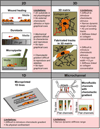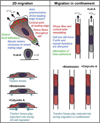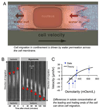Bioengineering paradigms for cell migration in confined microenvironments
- PMID: 24973724
- PMCID: PMC4354884
- DOI: 10.1016/j.ceb.2014.06.001
Bioengineering paradigms for cell migration in confined microenvironments
Abstract
Cell migration is a fundamental process underlying diverse (patho)physiological phenomena. The classical understanding of the molecular mechanisms of cell migration has been based on in vitro studies on two-dimensional substrates. More recently, mounting evidence from intravital studies has shown that during metastasis, tumor cells must navigate complex microenvironments in vivo, including narrow, pre-existing microtracks created by anatomical structures. It is becoming apparent that unraveling the mechanisms of confined cell migration in this context requires a multi-disciplinary approach through integration of in vivo and in vitro studies, along with sophisticated bioengineering techniques and mathematical modeling. Here, we highlight such an approach that has led to discovery of a new model for cell migration in confined microenvironments (i.e., the Osmotic Engine Model).
Copyright © 2014 Elsevier Ltd. All rights reserved.
Figures



References
-
- Reymond N, d'Agua BB, Ridley AJ. Crossing the endothelial barrier during metastasis. Nature Reviews Cancer. 2013;13:858–870. - PubMed
-
- Friedl P, Alexander S. Cancer Invasion the Microenvironment: Plasticity and Reciprocity. Cell. 2011;147:992–1009. - PubMed
-
- Alexander S, Koehl GE, Hirschberg M, Geissler EK, Friedl P. Dynamic imaging of cancer growth and invasion: a modified skin-fold chamber model. Histochemistry and cell biology. 2008;130:1147–1154. - PubMed
Publication types
MeSH terms
Grants and funding
LinkOut - more resources
Full Text Sources
Other Literature Sources

